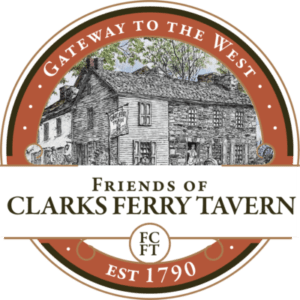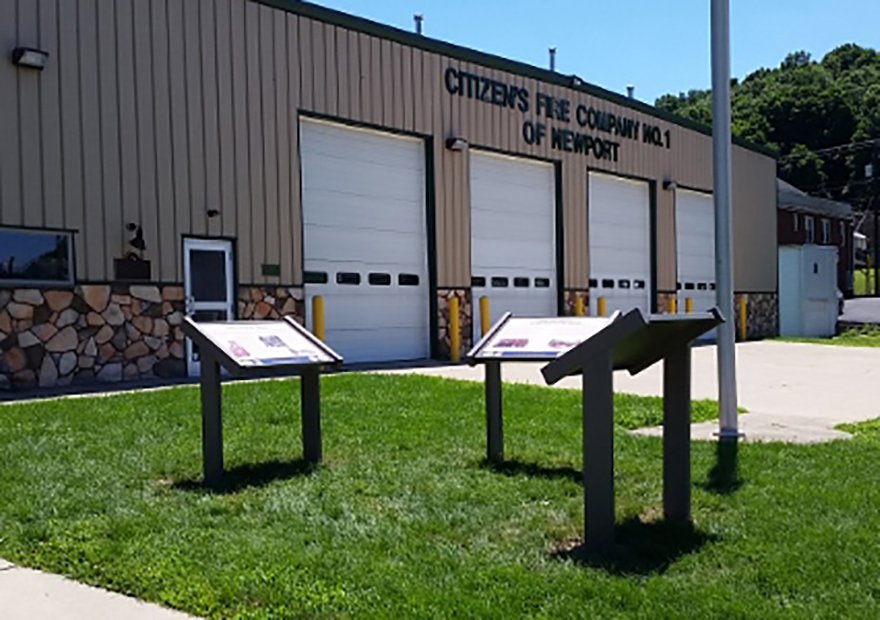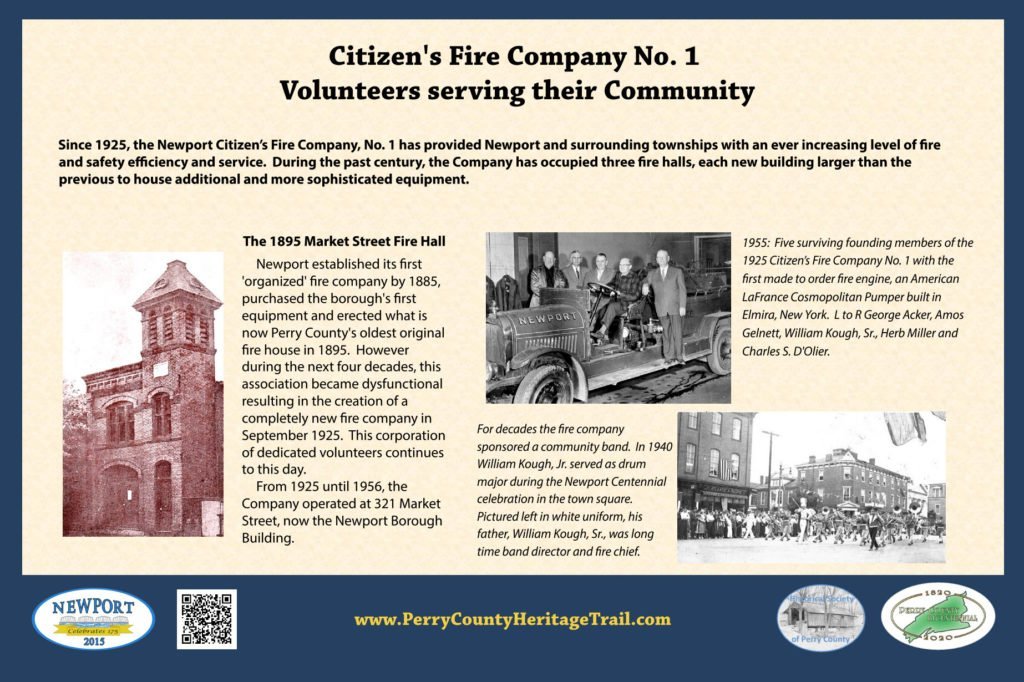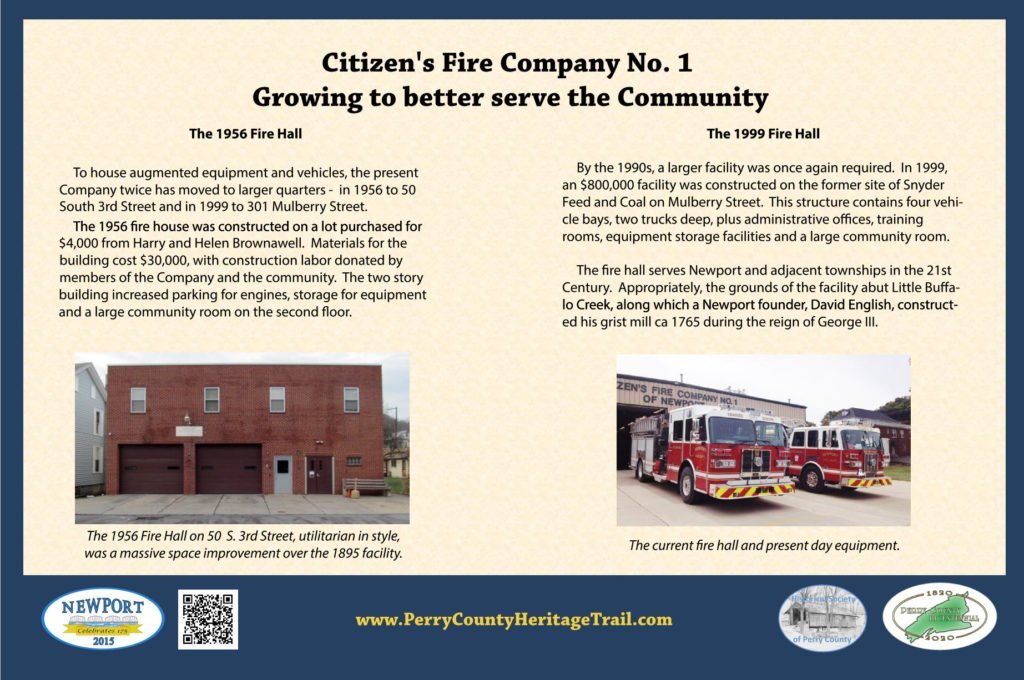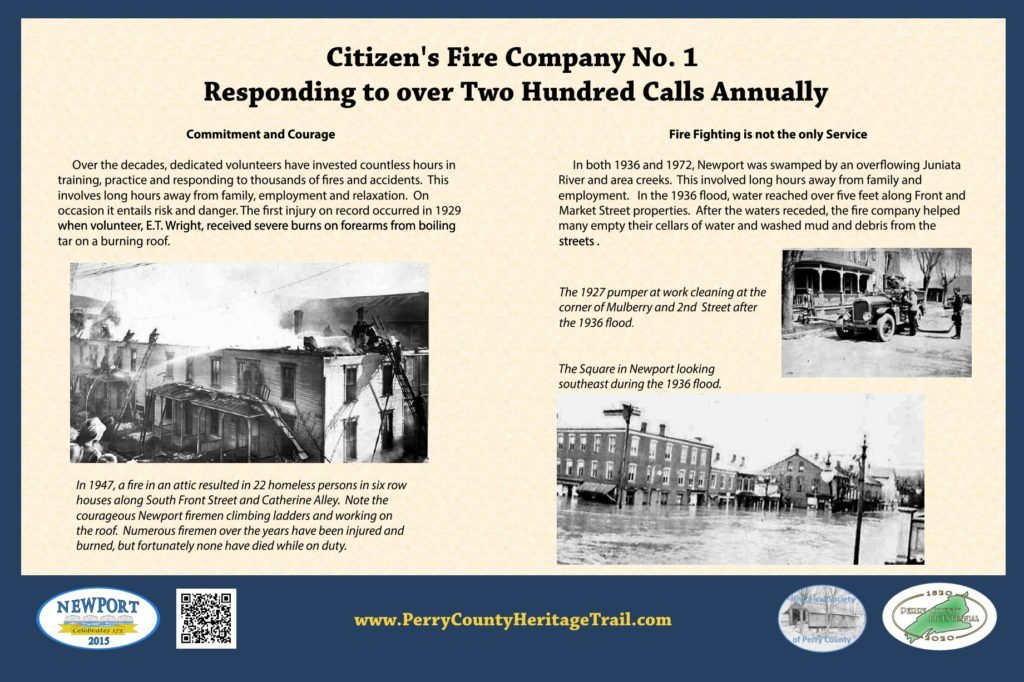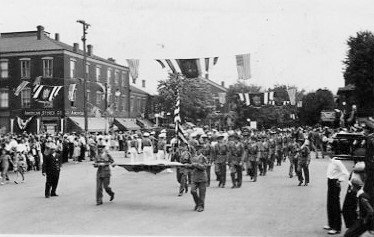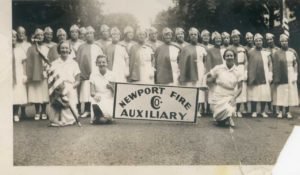Volunteers serving their Community
Since 1925, the Newport Citizen’s Fire Company, No. 1 has provided Newport and surrounding townships with an ever increasing level of fire and safety efficiency and service. During the past century, the Company has occupied three fire halls, each new building largerthan the previous to house additional and more sophisticated equipment.
The 1895 Market Street Fire Hall

Newport established its first ‘organized’ fire company by 1885, purchased the borough’s first equipment and erected what is now Perry County’s oldest original fire house in 1895. However during the next four decades, this association became dysfunctional resulting in the creation of a completely new fire company in September 1925. This corporation of dedicated volunteers continues to this day.
From 1925 until 1956, the Company operated at 321 Market Street, now the Newport Borough Building.

1955: Five surviving founding members of the 1925 Citizen’s Fire Company No. 1 with the first made to order fire engine, an American LaFrance Cosmopolitan Pumper built in Elmira, New York. L to R George Acker, Amos Gelnett, William Kough, Sr., Herb Miller and Charles S. D’Olier.
For decades the fire company sponsored a community band. In 1940 William Kough, Jr. served as drum major during the Newport Centennial celebration in the town square. Pictured left in white uniform, his father, William Kough, Sr., was long time band director and fire chief.
————————————————————————————————————————————————————————————————
Growing to better serve the Community
The 1956 Fire Hall
The 1956 Fire Hall on 50 S. 3rd Street, utilitarian in style, was a massive space improvement over the 1895 facility.
To house augmented equipment and vehicles, the present Company twice has moved to larger quarters – in 1956 to 50 South 3rd Street and in 1999 to 301 Mulberry Street.
The 1956 fire house was constructed on a lot purchased for $4,000 from Harry and Helen Brownawell. Materials for the building cost $30,000, with construction labor donated by members of the Company and the community. The two story building increased parking for engines, storage for equipment and a large community room on the second floor.
The 1999 Fire Hall
By the 1990s, a larger facility was once again required. In 1999, an $800,000 facility was constructed on the former site of Snyder Feed and Coal on Mulberry Street. This structure contains four vehi-cle bays, two trucks deep, plus administrative offices, training rooms, equipment storage facilities and a large community room.
The fire hall serves Newport and adjacent townships in the 21st Century. Appropriately, the grounds of the facility abut Little Buffa-lo Creek, along which a Newport founder, David English, construct-ed his grist mill ca 1765 during the reign of George III.
————————————————————————————————————————————————————————————————
Responding to over Two Hundred Calls Annually
Commitment and Courage
Over the decades, dedicated volunteers have invested countless hours in training, practice and responding to thousands of fires and accidents. This involves long hours away from family, employment and relaxation. On occasion it entails risk and danger. The first injury on record occurred in 1929 when volunteer, E.T. Wright, received severe burns on forearms from boiling tar on a burning roof.
In 1947, a fire in an attic resulted in 22 homeless persons in six row houses along South Front Street and Catherine Alley. Note the courageous Newport firemen climbing ladders and working on the roof. Numerous firemen over the years have been injured and burned, but fortunately none have died while on duty.
Fire Fighting is not the only Service
In both 1936 and 1972, Newport was swamped by an overflowing Juniata River and area creeks. This involved long hours away from family and employment. In the 1936 flood, water reached over five feet along Front and Market Street properties. After the waters receded, the fire company helped many empty their cellars of water and washed mud and debris from the streets .
The Danger of Fire
by Bob Flickinger and Glenn N. Holliman, Spring 2015
The danger of fire has bedeviled human communities since the rise of urban civilization. Prior to motorized vehicles, electric pumps and water lines, there had been no more frightening sound than a fire bell in the night! Such was certainly the case in greater Newport, a community of several thousand persons by the second half of the 19th century with numerous industries, two railroads and a tightly built-up commercial and residential area along the Juniata River.
One of the most destructive fires in Newport history occurred in June 2, 1874, when flames broke out in the Gantt stable on east Market Street near the Juniata River covered bridge. Approximately three tons of fresh hay had been stored in the loft, where the fire ignited.
The blaze quickly spread to the adjacent Gantt Hotel, and before the conflagration could be contained with buckets, ladders and hooks, much of the northeast corner of the Newport square was in ruins. At least eleven structures were burned to the ground and more damaged. So intense was the fire that the Harrisburg Hook and Ladder Company was summoned by telegraph to protect the 1851 Covered Bridge which caught fire six times during the ferocious fire.
Incredibly when an agitation started within days of the holocaust to create a fire company, the town council refused to vote the funds, stating the budget was depleted and the borough had no authority to assume debt!
The Creation of the First Newport fire company in the 1880s
After years of frustration on the part of some borough leaders, Newport in 1885 established its first volunteer fire department, which lasted for forty years albeit there was at least one reorganization. Below is a photograph of the company’s members from 1885-1888 and the names of those volunteers.
By 1895 a fire department building was constructed by the Newport Borough, located at 321 Market Street, one block west of the main market district, the Square. The Fire Hall is left of the grocery store, later the Moose Lodge and most recently, a pizza parlor.
Signage on the building attest to the original purpose of the facility. (2)
Equipment was purchased in 1896 – a hand drawn fire hose cart with 50 feet of hose and a hand drawn ladder cart.
By the middle 1890s a water system had been installed in Newport, thus significantly improving fire suppression. Fire hydrants were installed by the close of the 19th Century.
Newport’s first fire company had difficulty sustaining an organization.
By 1906 the organization of the 1880s Newport fire company had dissipated. In April of that year volunteers reformed the service and became known as the Newport Hose, Hook and Ladder Company. Officers elected were as follows in 1907: president The Rev. William Dorwart, vice president Fraua E. Taylor, and secretary W.W. Tharon and treasurer G. P. Bistrilina. Permission was given by the Borough council for the new company to use the fire apparatus on hand.
A wooden box with a glass front was installed by the door of fire department to hold a key allowing access to the equipment in case of emergency. Later 40 keys were ordered, one for each volunteer to have a key to the 1895 fire hall. In 1929 volunteer John Sanderson broke the box gave the alarm for a major fire at Gray’s Market on Walnut Street.
Running a fire company is expensive. Volunteers were assessed 50 cents membership fee and later 10 cents a month. Within a few months of organization, the group held a fund raiser at a fair and festival.
While equipment was still hand drawn, technology was changing. An electric striker for a cost of $160 was purchased and installed in the fire tower. The Pennsylvania Railroad, a major employer in town, provide an ‘engine tire’ (electric motor) to operate the machine. With the purchase of the striker, it was decided not to purchase a fire bell, an older method to summon volunteers to a fire.
Notwithstanding this fine start, the company went out of business in 1912 with the distribution of remaining funds of $79.82 to the Civic Club for erection of a public fountain in Newport.
The 1925 Citizens Fire Company, No. 1 established
In 1925 , the Underwriters Insurance Group in Philadelphia sent engineers to survey the town for the threat of fire. A detailed map of Newport with the names and locations of businesses and addresses of residents was produced and is available for inspection at the Perry Historians. Citizen Jeff Mattern has an original copy.
By September 1925, the Underwriters Group sent a scathing letter to the Borough Council demanding that a fire company with at least 25 volunteers, modern equipment and motorized vehicles be established for insurance rates would rise! This was a wake up call for Newport business leaders. An informal group gathered at John S. Eby’s Drug Store (currently the location of the Goodwill Store on northwest corner of the Square) and began to organize the Citizens Volunteer Fire Company, Number 1, a department that continues to this day.
An informal meeting was held September 30, 1925 in the borough offices to reconstitute a fire company. At the next October meeting the first officers were elected: Charles F. Lahr, president; Stanley G. Fickes, vice president; Henry D. Faul, secretary; Charles F. D’Olier and Paul R. Flore, treasurers and serving as trustees – Anson B. Wright, J. Howard Jones, Samuel Horting and John S. Kough.
That same fall 1925 the first fire officers were elected. They were William H. Kough, Sr. chief and district chiefs – Stanley G. Fickes, Clair Shoop, William B. Hoke and George M. Acker.
Motorized vehicle development had improved dramatically since the 1906 -1912 company folded. By 1925 Newport had five automobile garages, and livery stables for horses was becoming a memory. As with the earlier fire company, funding was a priority, especially with the purchase of a first vehicle, a Hudson truck, a makeshift contraption, that carried hose, buckets and ladder. The Hudson was still being used at least as 1936. At last the 1895 hand drawn hose cart was retired and is on display in the Fire Hall.
Below, a 1920s Hudson truck modified as a fire engine. Unfortunately no picture exists of the Newport vehicle. This picture was taken in 1962 of a New Zealand fire company lorry, which adopted the model for the same service as did Newport.

The Hudson was replaced by a genuine fire truck in December 1926, an American LaFrance Cosmopolitan Pumper which served the community until 1947. Built in Elmira, New York, the pumper could deliver 500 gallons of water per minute. The equipment found a lot of uses.
Below a 1950 photograph of the 1949 engine on the left and the 1927 pumper on the right. Taken on the site of the former Bechtel Tannery, now Veteran’s Park.
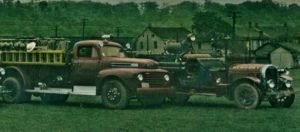
In 1928 alone there were 20 fire calls – nine in the Borough, five outside of town and the rest in east and west Newport. Damage in the Borough was estimated at only $850; the fire company was accomplishing its mission! Between 1926 and 1940, there were over 700 fire calls to which the company responded!
In the 1930s chimney fires were almost two thirds of all calls. By the 21st century with homes heated with electric and natural gas, chimney fires only average once a year calls. However, with the advent of the four lane Highway 322 in 1965, standard operating procedure dictated that a fire engine respond to serious accidents. In addition to traffic control and suppressing any blazes, newer equipment carried machinery to rip open any collapsed vehicles to reach injured passengers. By the year 2000, the majority of responses were of this nature. By the year 2010, the Company was responding to an average of 200 calls annually for all types of situations, more than triple the annual rate of the 1930s.
The Fire Chiefs
- William H Kough 1925-1952
- Raymond Himes 1952-1959
- Herbert M. Flickinger, Jr. 1959-1982
- David H. Oren 1982-1993
- Steve Flickinger 1993- present
Fire and Flood
By the late 1920s, people were driving their own cars to observe fires. A fire patrolman had to be appointed to direct traffic and to keep onlookers away from the equipment and operations. For the first time, the Borough passed ordinances to prohibit parking in front of fire hydrants and the Fire House.
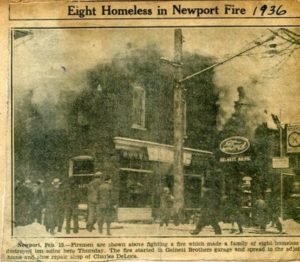
The Company placed a siren control in the telephone exchange so that the operator could sound the alarm when a call announcing a fire occurred. Until 1956, if one dialed the fire department, the phone could be answered in three places – the telephone company, Flickinger’s Appliance Store or Newlin’s Barber Shop next to the fire Hall. Whomever answered first, pressed the fire alarm!
Left: the Gilnett Ford Company, adjacent to the Fire Hall suffered a furnace fire in 1936 which spread from the basement. Over 40 cars were saved but three were lost. The family of eight next door lost their home. Ironically Amos Gilnett, owner, was one of the founders of the Fire Company!
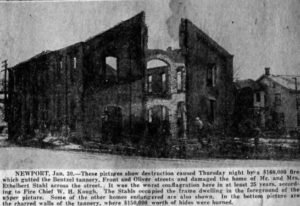
In 1947, right, the former Bechtel Tannery building on Front Street, then owned by Jesse Bentzel, a hide dealer, caught fire. The News-Sun picture captures the remains of what was once Newport’s largest industry. A neighboring house went up also, but quick work by the Fire Company saved others. As noted, today the site is the Veteran’s Park.
The fire company served the community during the disastrous 1936 flood when the overflowing Juniata River sent as much as six feet of water into the Square. Below the south east corner of the Square, the same area destroyed by the 1874 fire.
A boat floats down Walnut Street toward the Pennsylvania Railroad tracks.
In 1931, J. H. Jones donated a container and tank of oxygen for the Company’s first aid team. By the next year, the first aid group was receiving training regularly. As noted by the middle 1930s, this service began to evolve into an ambulance service. Next photograph attendants carry a portable cot. One ambulance was purchased from Funeral Director David Myers for $300. The old one was sold for $20.
The Newport Fire Company Band
The Newport Citizens Band was incorporated into the fire department in 1930, with the purchase of $784 worth of uniforms. During the decade prior to World War II, the band represented the company at local events and firemen’s parades and conventions throughout Central Pennsylvania and won many awards. A highlight was marching in the 1930 Governor’s inauguration in Harrisburg.
Below, the band in their 1931 uniforms posing in front of the Newport Pennsylvania Railroad Station. In that day, rose bushes banked the depot, a facility now in ruins, and the side of a motor vehicle garage since 1961.
The uniforms in the next picture were purchased from the Wellsboro American Legion post which folded it’s band sometime in the middle 1930s. For $500, Newport purchased uniforms, sheet music and musical instruments. The uniforms above, with their ‘military’ look, replaced the 1931 blue shirts with white lapel trim.
In this snappy 1940 picture in the Newport Square, front row, far left, is William Kough, Sr., dressed all in white carrying his baton as band director. The drum major is William Kough, Jr. who would later serve as an officer in World War II and eventually move to California. At the deaths of Bill and his wife, Anne, their estate generously underwrote the construction of the Newport Public Library building on north 4th Street.
Below Bill Kough, Sr. leads both the Newport and New Bloomfield combined bands at a concert on the Newport Square in 1940.

Due to war time conditions the band cease operation in the 1940s, and an attempt to revive it in 1950 failed. Times had changed, but a drum and bugle corp., a smaller ensemble players and instruments, began in 1959 and lasted until as late as 2013 before it folded.
Fire Department Parades
The Fire Company itself often marched in parades in neighboring towns. Generally during the 1930s, four to five invitations a year were accepted and the volunteers turned out in uniform to march. Only death or illness of a family member excused a marcher, and if one was absent, a 50 cent fine was administered!
In 1932 the Company took advantage of a $4.50 round trip ticket to travel to Washington, D.C. to march in the Labor Day parade honoring police and fire companies of the nation. Unfortunately, the train left Newport at 3:50 am, arriving in the nation’s capitol at 7:55 am. The volunteers could return on their own time.
For one trip to Lock Haven in 1933, the Company provided 3 gallons of gasoline for each person hauled in a member’s car, plus one quart of oil for each fifteen gallons of gas consumed.
The image to the right shows the fire company standing for inspection in their pre-1940 uniforms. Below parading through Newport in their military style uniforms just prior to World War II.
Parades of the Company marching in unison became fewer and fewer after the War, finally dying out completely in the 1980s. Free time for volunteers became scarcer and had to be invested in training and mastering increasingly technical equipment.
The Ladies Auxiliary
As early as 1928, the Fire Company was holding an annual carnival to raise funds, raising over $1,100 that first year. For decades profits from a carnival or festival supplemented income from the Borough and townships.
These fund raisers, including tickets to movies and plays, were successful due in large part to the Ladies Auxiliary of the Company. Formally constituted in 1931, the Auxiliary supplied coffee and sandwiches at fires and to this day insure that benefit dinners and lunches are held.
Below at Lewistown, Newport in the 1930s, firemen march with a member of the Ladies Auxiliary parading also in uniform.
Below, the Auxiliary marched in Carlisle, ca 1939. The members are described as ‘nattily-attired (and they were!).
Community Service
As if being available for fire, flood and accidents was not enough, by 1928 the Company became responsible for the Newport Christmas tree and carnival lighting. However, due to economic conditions, no tree was put up in 1930 due to the cost of electricity. The custom revived in 1931 and continues to this day.
By the late 1930s, the fire department also took on the task of organizing the Halloween Parade of children in the Borough. For a time in the 1930s, the Company sponsored a basketball team and operated a horse shoe league on John Kough’s propery on N. 3rd Street. Lights were installed and six to eight pits operated into the evening. All this before television in the 1950s changed evening habits.

World War II Activities
During World War II many of the younger volunteers of the Company went off to serve in the military. The Company voted Christmas 1942 to send all Company members who were in the service cartons of cigarettes. When they came home, a homecoming parade was held and the Fire Company Band played and marched, but did so few times afterwards.
Long serving Fire Chief (and bandmaster) William H. Kough, Sr. served also as head of the Civil Defense and gave talks such as the one recorded below. David Myers took the position of Air Raid Warden and in 1942, the whole town ‘blacked out’ for a practice. Citizens, such as young Bob Flickinger, later a member of the Company, took four hour turns as an airplane spotter serving from a lookout tower on Middle Ridge.
Fire and accidents did not take a holiday during the War. In 1943, a Pennsylvania Rail Road passenger train derailed in Newport, and one soldier died. The next day, a Newport boy, exploring on the remains of the wreck, was struck and killed by a second train.
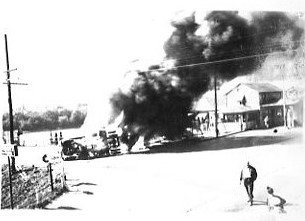
Lest we forget, fire fighting is a dangerous business….
1951, truck fire on the east side of Newport closed the Juniata River bridge for hours.
In 1941, the milk plant office, formerly the Oak Extract office, burned to the ground on North 4th Street in Oliver Township. The volunteers of the Company served many hours and exposed themselves to risk on this and many, many other occasions.
Below the Wentzel Mill on S.4th Street 1957.

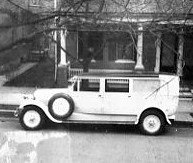
It is to the fire department that the community owes a debt of gratitude for establishing the first ambulance service in the 1930s. Below, one of the first ambulances ca 1940 in Newport. The program averaged 35 calls a year by 1939. The service was free, unless someone wanted to make a five dollar donation for a ride a Harrisburg hospital. Today, ambulance service is a separate company and located in the 1956 Fire Hall.
